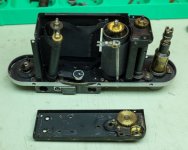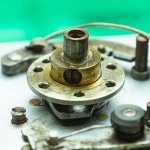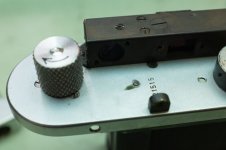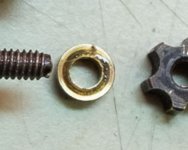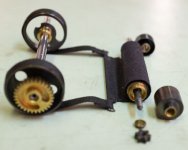GMOG
Well-known
Greetings! I've been lurking on this site for a while now, after finding a lot of good information here related to servicing old Leica screw mount cameras. I'm a Swiss and USA certified watchmaker, and a photographer. I spent years specializing in Rolex service, but now I only work on vintage watches, wrist and pocket. When I get photo work it's on the commercial side of the spectrum. I've got a few camera repair successes under my belt, including the servicing of a few large format Copal and other similar shutters. I also replaced the 1st shutter curtain in a Canon II-F I own and now shoot photos with.
Anyway, what brings me here is a question I have about a Leica IIIa I have on the bench now. It has too much oil in it, and I want to take the shutter rollers out and apart so I can properly clean these parts before applying fresh oil.
Here's as far as I've gotten:

I can't remove the rollers and curtains because I cannot remove the "perforated settings disc" up top:

I have removed the screw, but the disc will not come off the shaft easily. I've tried rotating it but cannot get good enough grip. I've tried gentle prying to no avail. I also tapped the shaft with a small brass watchmaker's hammer, to see if I could push it through, but it won't budge and I dare not apply more force.
Any tips for getting this piece off without damaging anything? Is there a special puller for this job?
It appears I could remove the rollers after removing the gear that's mounted to the lower end of the shaft, but that would leave the shaft in place and prevent me from cleaning those parts up top like I'd like to.
Something I notice about this shutter, and is why I want to take it apart for a good cleaning, is that the speeds vary greatly between when the camera is cold (~40F ambient temp), compared to the speeds when at higher temps (~70F ambient temp). When cold 1/1000 is way too fast (1/2000 - 1/3000, or not measurable) and unusable I'm sure. When warmer 1/1000 = 1/700 or thereabouts. In both situations the speeds are closer and usable as you go down from fastest to slowest, but cold always presents a bias towards being fast. I've read about people using these cameras in cold weather without trouble, so I'd like to get this one to perform more consistently.
My theory is that the abundance of oil is causing the problem. When cold the oil thickens, and since there's too much of it in there it has a greater impact on timing. The oil could also be too viscous for this application, which gives me more cause to remove it and lube with some fine, light synthetic watch oil.
Thanks for reading!
PS - I'm using a Phochron XA shutter tester, with the sensor for focal plane 35mm shutters.
Anyway, what brings me here is a question I have about a Leica IIIa I have on the bench now. It has too much oil in it, and I want to take the shutter rollers out and apart so I can properly clean these parts before applying fresh oil.
Here's as far as I've gotten:
I can't remove the rollers and curtains because I cannot remove the "perforated settings disc" up top:
I have removed the screw, but the disc will not come off the shaft easily. I've tried rotating it but cannot get good enough grip. I've tried gentle prying to no avail. I also tapped the shaft with a small brass watchmaker's hammer, to see if I could push it through, but it won't budge and I dare not apply more force.
Any tips for getting this piece off without damaging anything? Is there a special puller for this job?
It appears I could remove the rollers after removing the gear that's mounted to the lower end of the shaft, but that would leave the shaft in place and prevent me from cleaning those parts up top like I'd like to.
Something I notice about this shutter, and is why I want to take it apart for a good cleaning, is that the speeds vary greatly between when the camera is cold (~40F ambient temp), compared to the speeds when at higher temps (~70F ambient temp). When cold 1/1000 is way too fast (1/2000 - 1/3000, or not measurable) and unusable I'm sure. When warmer 1/1000 = 1/700 or thereabouts. In both situations the speeds are closer and usable as you go down from fastest to slowest, but cold always presents a bias towards being fast. I've read about people using these cameras in cold weather without trouble, so I'd like to get this one to perform more consistently.
My theory is that the abundance of oil is causing the problem. When cold the oil thickens, and since there's too much of it in there it has a greater impact on timing. The oil could also be too viscous for this application, which gives me more cause to remove it and lube with some fine, light synthetic watch oil.
Thanks for reading!
PS - I'm using a Phochron XA shutter tester, with the sensor for focal plane 35mm shutters.


